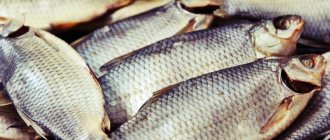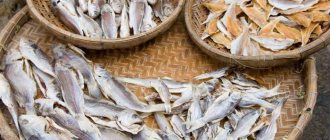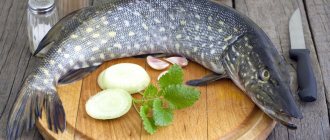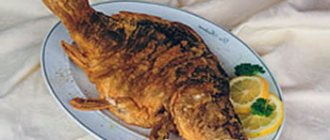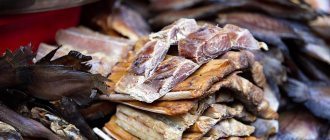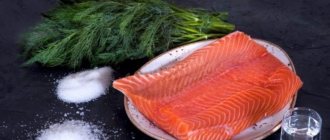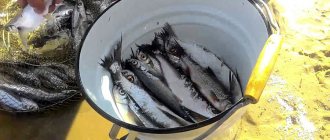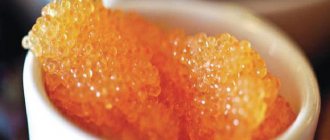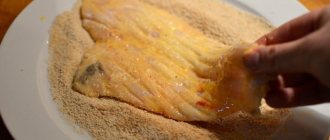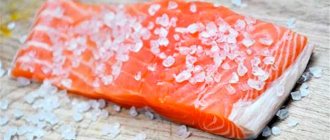Using this simple salting recipe, sprat, sprat, anchovy and many other small species of fish are salted. The salting process is simple and anyone can do it easily. The main thing is that there is a desire.
Any enamel dish is suitable for pickling. If the fish is very small, it may not need to be gutted. We carry out the salting process in a cold place.
All you need is:
- food nitrate (proportion to salt 1 to 10 parts) - if unavailable, replaced with aspirin;
- black allspice peas;
- cloves, cumin, currant leaves - as spices.
Salt small fish with dry, spicy salting.
Rinse the fish in cold water and allow excess liquid to drain.
Then, we coat the carcasses with salt (it should “stick” to the fish) and quickly transfer them to the prepared container, not forgetting to sprinkle with spices.
We put oppression on top and wait for the “trifles” to salt. This takes no more than 1-3 days.
All that's left to do is transfer the spiced salted fish into a smaller container to store in the refrigerator.
Heavily salted small fish must be soaked before consumption.
See also video recipes: Quick salting of capelin at home - spicy salting using a dry method.
Video: DRY AMBASSADOR KHAMSI, KHAMSA.
Spicy salting of whole fish according to the classic recipe
Brine for herring at home differs from its analogue produced at fish factories in quality and composition. Its volume is calculated based on the number of fish carcasses that will be salted.
For example, for spicy salting, 3 medium-sized herrings will be needed:
- 1.5 liters of water.
- 5 pieces. allspice.
- 4 bay leaves.
- 7 tbsp. l. table salt.
- 3 tbsp. l. Sahara.
- 2 tsp. mustard.
- 20 black peppercorns.
- Cilantro and coriander - to taste.
Brine prepared at home does not have to be prepared in a special container. For salting herring, an ordinary nylon bucket or a large saucepan may be sufficient, but such containers will never compare in quality to an ordinary oak barrel.
The contact of the brine with the wood allows you to extract from the oak not only the smell, but also the chemicals and vitamins accumulated in it, which, together with the brine juice, will penetrate into the fish carcass in order to subsequently impart all their most beneficial properties to the people sitting at the dinner table.
- At the first stage, fill a saucepan with a volume of at least 2 liters with water and place all the prepared seasonings in it.
- After placing the container on high heat and bringing the water to a boil, wait a couple of minutes and remove from heat.
- Once the brine has cooled to room temperature, pour it into a container with a tight-fitting lid. The brine is ready.
Classic herring brine recipe
After the herring is placed in it, the container should be tightly closed and left in the refrigerator for 3-4 days, after which the fish will be ready to eat.
Salting fish at home
Fish is salted at home in different ways. Wet salting is used to ensure uniform penetration of salt into the carcass of uncleaned fish.
Usually small river fish of the carp family are salted in their own juice: white-eye (sop), blue bream, roach, white bream, silver bream, perch, rudd.
Common sea fish are also suitable for wet salting: mackerel, herring, horse mackerel, sprat, anchovy.
Wet home salting is especially often used for long-term storage of herring of all breeds.
Wet homemade fish salting
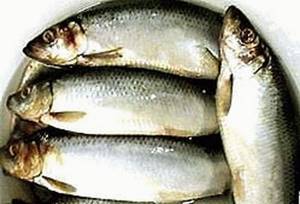
Salt consumption per 10 kg of fish with moderate salting is 1.5 kg. Strong wet salting consumes 2.5-3 kg of salt.
To better protect the fish from spoilage, add food saltpeter to the brine in a ratio of 10:1. To make the fish more tender and tastier, you can add a tablespoon of sugar per kilogram of salt to the wet salting recipe.
To wet salt fish at home, pour a layer of salt on the bottom of the dish and tightly lay the layers of carcasses belly up. Sprinkle each layer of fish with coarse salt. Place a wooden circle and a bend on top.
The more fish is salted, the heavier the load should be. Place the container with wet salted fish in a cool place.
After 1-2 days, the moisture released from the fish will cover it completely. On the 3-8th day (depending on the weight), homemade fish is completely salted.
Rinse the finished wet-salted fish in running water and air dry. Store in a cool place in a wooden box.
Brine for pickling red fish
Properly salted red fish is a table decoration, a very tasty base for sandwiches and a component for many other mouth-watering dishes. The brine for pickling red fish must include sugar so that the dish turns out slightly dried and with a more pronounced taste.
Ingredients:
- fish (salmon or salmon) – 1 kg;
- water – 1 l;
- salt – 4 tbsp. l.;
- sugar – 1 tbsp. l.;
- bay leaf – 2 pcs.;
- peppercorns (allspice and black) – 6 pcs.;
- cloves – 2-3 pcs.;
- lemon juice – 2 tbsp. l.

Remove the head and tail from the salmon/salmon, cut the carcass along the ridge into two parts. Place the fillet in a container or enamel pan. Boil water, stir in seasonings, and pour the mixture over the fish. Pour lemon juice over the top of the pieces, then tightly cover the container with a lid. Leave the workpiece to cool at room temperature for 2-3 hours, then put it in the refrigerator for 2 days. Remove the finished product from the brine, dry with napkins and wrap in cling film. Keep refrigerated.
Advice! Red fish, cut into small pieces, will be ready within a day after being immersed in brine. You can try it, but it is not recommended to serve it before it has been dry for 1-2 days.
Salting fish in brine
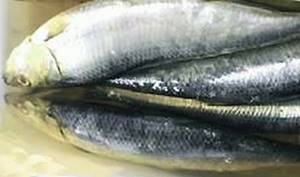
In addition, medium-sized and large fish are cleaned before salting.
To salt 3-3.5 kg of fish in brine you will need: 2 liters of water, half a kilogram of salt, 10 black and allspice peas, 2 bay leaves.
To prepare the brine, boil all ingredients and cool.
To salt the fish, peel the scales, remove the entrails, place in a container, fill with brine, and press under pressure.
After 3 weeks of salting, the fish will be ready to eat.
In this method, herring, sardines, anchovy, and sprat are salted whole in brine.
So much brine is prepared so that the fish is immersed in it. After salting, the container with fish is stored in a cool place.
River fish: how to salt
Brine for river fish does not have any major fundamental differences.
Ingredients:
- two liters of water,
- salt (480 g),
- black pepper,
- Bay leaf.
This amount of ingredients is given for salting three kilograms of fish. Medium-sized carcasses must first be gutted and washed. It is not recommended to salt the whole fish. The carcasses are placed in a container and filled with brine. It is imperative to use oppression. The brine is prepared by boiling. But they pour it over the fish only after it has completely cooled. The finished product can be consumed only after three weeks. The recipe is suitable for salting sprat, anchovy, sardines, and herring. Small fish can be salted whole. It is worth remembering that after cooking the product must be stored only in the refrigerator.
Marinating fish when salting
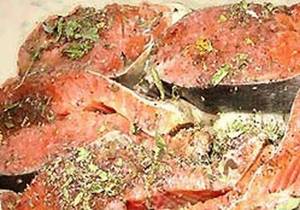
In addition, marinating allows you to reduce the salt content in the salting mixture without the threat of spoilage of the fish.
There is a distinction between spicy-salted fish, prepared with a mixture of salt, sugar and a selection of spices. Such as bay leaf, coriander, dill seeds, cloves, cinnamon, allspice, cardamom. It all depends on your taste.
But it will not be marinated fish, but salted fish. With spices, you can salt fish according to the recipe for salting fish in brine printed above.
When marinating fish, in addition to spices, vinegar or its replacement, citric acid or lemon juice, must be added to the pickling mixture.
Thanks to the preservative effect of sugar, spices, and especially acid, the dose of salt when marinating fish can be reduced, thereby improving the taste and speeding up the ripening process of the product.
Salting fish for drying
Those who like to feast on taranka can use the recipe below for salting fish for drying:
- take a wooden box, fill its bottom with salt (with a layer of about 1 cm);
- Place the fish, cleaned of entrails and husks, on top of the salt and cover it with salt (it is very important that this layer of salt is the same as that under the fish );
- then the next layer is laid out and so on to the top;
- a heavy load is placed on top of the fish (for example, bricks or heavy three-liter jars);
- after 5 days, remove the fish, rinse it of salt in clean running water and place in a dry pan;
- fill the fish with water and leave in this state for one hour (this is necessary so that all the excess salt that the fish has absorbed comes out of the fish);
- after 60 minutes, remove the fish and place it on dry towels to dry and allow all the juice to drain out;
- hang each fish on a thread and leave it to dry for 10 days (the larger the fish, the longer it needs to dry).
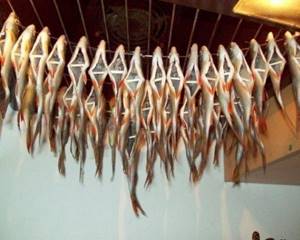
Keep in mind that in the process of salting fish for drying, it is necessary to take into account the air temperature. If it's summer outside, the fish will dry much faster.
Spicy pickling of river fish
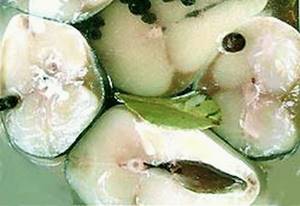
Spicy-salted river fish fillets are used for preparing salads, appetizers, and sandwiches.
To salt a kilogram of large river fish you will need: half a glass of salt, a teaspoon of sand.
For the spicy mixture: 5 peas of crushed allspice, a pinch of ground cinnamon.
First, let's prepare a spicy pickling mixture: to do this, mix salt with granulated sugar, cinnamon, and pepper.
We fillet large river fish, remove bones and cut into pieces. Fish with a low content of small bones can simply be cut crosswise into thin portions.
Rub the steaks with a mixture of spicy preservatives and place them in a stainless steel dish.
After salting, press the fish with a weight and place it in a cool place.
In two days, the spicy-salted river fish will be ready to eat.
Spicy home-salted capelin
To salt a kilogram of capelin at home, you will need a third of a glass of salt and a tablespoon of sugar.
For the spicy mixture: 6 allspice peas, 2 bay leaves, 2 tablespoons 9% vinegar.
Gut the capelin carcasses, remove the heads, place small fish tightly in a tray or jars.
To prepare the spicy mixture, pour a liter of boiling water over salt, sugar, peppercorns, and bay leaves. Stir vinegar into the cooled brine. Pour the prepared solution over the fish.
In a day, home-spiced capelin will be ready to eat.
Brine fish ambassador
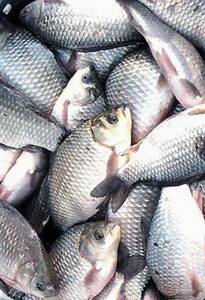
With brine salting, an aqueous solution of salt is prepared by yourself, and the juice secreted by the fish increases the total volume of the brine.
Along with the juice, some organic substances pass from the fish into the brine.
The salting solution, enriched with soluble proteins, minerals and fat, is called brine, in which the fish is salted.
The salt concentration during brine salting of fish is maintained at a constant value, for which the cloudy brine is drained and replaced with a new one.
After salting the fish, the brine should be poured out and the fish should be dried. Brine-salted fish can be stored for a long time.
Recipe for brine salting fish
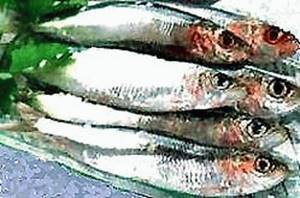
Dip a raw egg or raw potato into the brine. With the correct concentration of salt in the brine, they should float.
The brine salting recipe is convenient for salting small fish. Do not wash the fish, but wipe it with a dry towel.
Thread a string into 8-10 fish carcasses. Dip the bunch into brine brine, which should cover the fish completely. Place a weight on top.
To prevent microbes from multiplying in the brine, periodically drain it and replace it with fresh one.
When salted with brine, small fish are salted in 2-3 days. When salting gutted fish weighing up to half a kilogram, the weight of the oppression does not play a special role.
For medium and large carcasses, the weight of the cargo for high-quality brine salting should exceed the total weight of the fish by 1.2-1.5 times.
Change the brine twice: on the 3rd and 6th day of pickling. The volume of brine poured should be equal to the volume poured out.
Fish weighing up to a kilogram prepared according to this recipe is salted in 5-8 days.
After brine salting, remove the fish from the container, rinse for half an hour in running water, and hang to dry.
Balykov fish ambassador
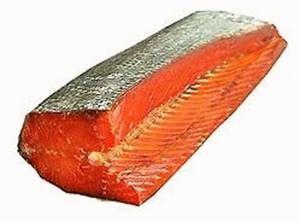
Before balyk salting, wash and gut the fish. Cut off the head and tail.
Using scissors, cut off the belly part a couple of centimeters below the side line of the fish. The carcass should be dried with a towel.
For balyk salting of asp and bream, you can leave the head on the fish, but be sure to cut out the gills.
If the prepared fish carcass weighs more than 2 kg, then cut it along the spine from the inside, without cutting the skin on the back.
Prepare the balykov salting mixture: mix 10 tablespoons of salt with 4 tablespoons of sugar, pinches of ground cinnamon, coriander, and pepper.
Rub the mixture into the scales, sprinkle it generously on the inside of the belly, and if the fish is layered, then between the layers.
Wrap each balyk carcass in canvas and tie it tightly along its entire length with twine. Place the fish in the refrigerator for 7-10 days to salt.
Drain the brine as it appears. After balyk salting, remove the fish from the cloth, rinse with cold water, and wipe dry.
Salted balyk fish can be stored in the refrigerator for a long time if it is periodically rubbed with vegetable oil.
Simple home-salted mackerel
Simple home-salted mackerel is used as a fish additive in flavored fish salads and snacks.
Recipe for salting 2 large mackerel: 100 g salt, 2 tablespoons sugar.
Dissolve salt and sugar in a liter of boiling water.
Gut the mackerel, cut off the heads, cut crosswise into portions, and place in a jar.
Pour the cooled brine over the mackerel pieces and place in the refrigerator for 2 days.
Simply salted mackerel will be ready in a day.
How to salt river fish - simple rules and tips
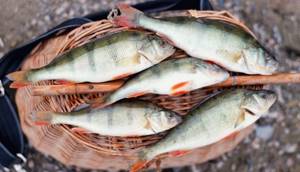
In this article we will share with you simple secrets on how to salt river fish. Small or large, dry salted or in brine, for drying or drying.
The beauty of fishing for many lies not so much in the process itself, but in the direct preparation of the caught fish.
Salting is the most popular processing option for river catch. Read on to learn how to salt fish at home.
How to salt river fish - tasty and correct?
The most common method of heat treatment of catch is frying.
But what if there is simply no one to feed with a large number of fried trophies?
This is where salting comes to the rescue.
This process is quite simple and will allow you to extend the pleasure of eating fish for a considerable period of time.
Let's try to figure out how to quickly and tasty salt some types of river fish with our own hands.
Types of river fish optimal for salting
Fish is the healthiest product in nature, rich in various vitamins and microelements.
It is ideal for drying or salting.
River fish caviar is also very useful.
Let's look at what types of river inhabitants love salt, and as a result, they make an excellent snack.
For salting, it is good to use all representatives of red river fish and all various small species of river fish (perch, roach, crucian carp, etc.)
Remember that the shelf life of salted fish is still not very long.
As a rule, freshness is maintained for two weeks, depending on the type of fish and the salting recipe.
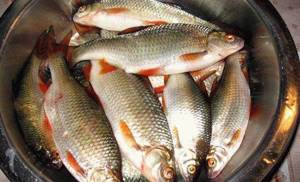
Methods for home salting river fish
There are various types of salting fish at home.
There are many types of homemade pickling, we will look at the two most popular:
- dry salting or cold salting;
- salting in brine;
The main rule before preparing salted fish is the right utensils and high-quality ingredients.
In order for the salting to be completed successfully, several rules should be taken into account:
- Utensils for mixing should be enamel or glass.
- It is necessary to choose rock salt and coarse enough, because... it will thoroughly saturate all layers of the fish.
- Freshly caught catch will be tastier, but if the fishing season has already passed, you can purchase a freshly frozen specimen and defrost it under hot water or at room temperature.
- Not every breed needs to be thoroughly cleaned and washed before salting.
Dry salted fish
Most often, river fish is salted using the dry salting method. We'll tell you about it.
- First, let's prepare a homemade marinade: put 150 grams of salt on a plate, and also add pepper, bay leaf and 50 grams of sugar.
- Thoroughly rinse the defrosted fish carcass under a cold water tap.
- Remove skin and bones (if possible);
- The carcasses should be placed on a plate with their back down and sprinkled with all the seasonings indicated in the list of products;
- We close our preparation and leave it in the refrigerator for three days.
In any salting recipe, you should always take into account that salt with small particles can only over-salt the fish fibers.
Another option for dry pickling.
- wooden container (this can be a basket or a small box);
- thick fabric;
- fish;
- sugar, salt
- We clean, rinse and dry the sockeye salmon.
- We place it on the bottom of the basket, having previously spread out a coarse cloth.
- We coat each of the fish with salt on all sides and not forgetting about the mouth and abdomen.
- Lay the carcasses evenly on the prepared surface. There should be no distance between the bodies.
- When everything is laid out, you need to close the box and press it down with a fairly heavy weight.
- Leave in a cool place for a week so that each fish is well salted.
- As soon as the scales become a little hard to the touch, they must be removed from the resulting juice and left to air dry.
How to salt perch for drying?
Preparing dried perch:
- We wash the perches under cold running water.
- Pour coarse salt into the bottom of an enamel pan.
- The salt layer should be no thinner than 0.5 cm.
- Place the fish tightly on top of the salt.
- Sprinkle with salt again.
- Once again we lay out the perches, etc. until we post everything.
- The final row should consist of salt.
- We close the container and press it with significant weight.
- Leave the pickling in a dark place for about a month or 40 days.
- After the above period, the carcasses must be distributed along the length.
More well-fed representatives need to be soaked for about 1.5 days, changing the water in a barrel (or any vessel suitable for pickling) three times.
Water calculations are based on 5 liters of cold water per 2 kg of fish. The salting process itself should take place in a dark place with average temperatures. It is not recommended to close the lid completely!
Drain all the water and let it dry a little.
We stretch a strong rope in a well-ventilated area with low humidity. You can prepare wire hooks in advance or use old plastic clothespins.
We hang the perches by pinching their upper lip.
To slightly protect the product from drying out, you can cover them with gauze. If drying occurs in the summer, it is worth protecting the fish in advance from sudden precipitation.
To do this, you need to cover all the perches and crucian carp with plastic material. But at the same time, after the sun appears, such “cover” must be immediately removed.
Next, the question logically arises: “How many days does it take to dry river mining?”
And here you should rely on your instincts and personal preferences. It happens that a couple of days are enough for good drying, and sometimes it may take 4 or even 5 days.
Salting river fish yourself is not difficult and very tasty.
Properly selected ingredients and proper proportions will give ordinary river fish a unique aroma and unforgettable taste.
The problem, however, can be caused by the meticulous removal of bones from the fleshy veins.
But if you have a little patience, the result will exceed all expectations.
We hope now that you know how to salt river fish, you will do it more often.
Recipe for universal salting of any fish
- Salting time is 7-10 hours.
- Kitchen appliances and utensils: bowl, container with lid, flexible short knife, fish cutting board, kitchen scale, spoon, paper towel.
Ingredients
| Name | Quantity |
| River trout | 400-450 g |
| Water | 1 l |
| Coarse salt | 90 g |
| Bay leaf | 4-5 pcs. |
| Fresh dill | ½ bunch |
| Vegetable oil | 1 tbsp. l. |
Step-by-step salting of trout fillet
In this recipe, every moment is important - how to cut the fillet, how long you need to salt the fish and how much salt is needed so as not to oversalt it. I will try to tell you in great detail.
Fillet cutting technique
- Cut off the fish's head and thoroughly gut the carcass.
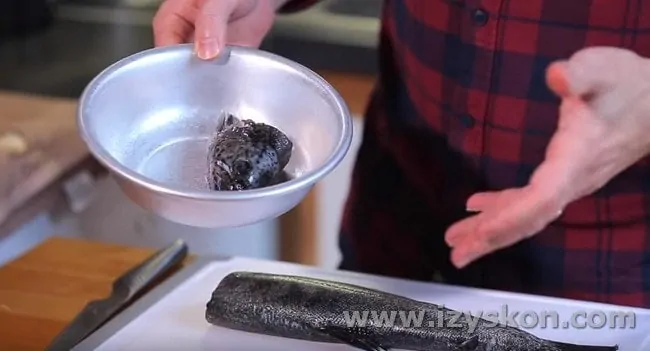
- Place the carcass with the ripped belly facing you and separate the meat from the ridge with a short flexible knife, moving from head to tail.

- Without turning the carcass over, cut off the ridge, holding it with four fingers so that the carcass does not slide on the board, and cut off the caudal fin.
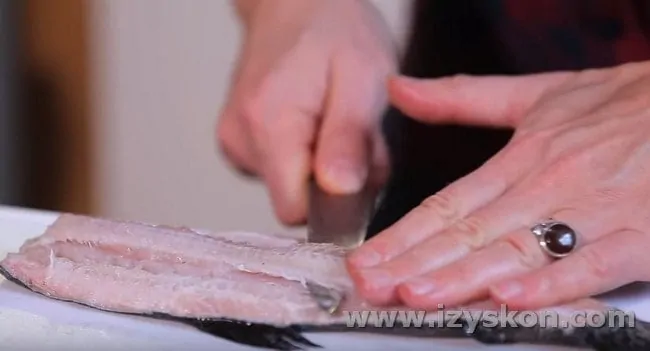
- Cut off the large dorsal fin. Cut out the pelvic fin.
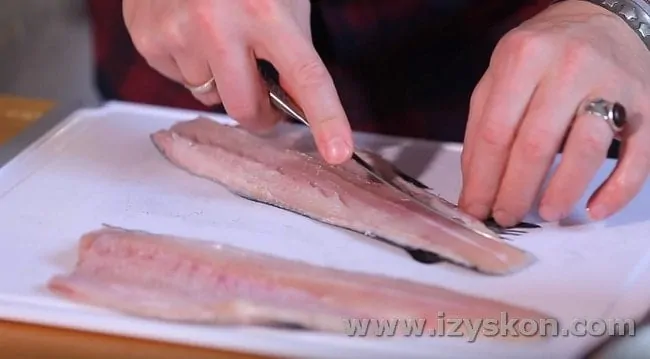
- Carefully cut off the rib bones.
Did you know? The head, fins, rib bones and backbone make a great ear! You just need to remove the gills from the head before cooking.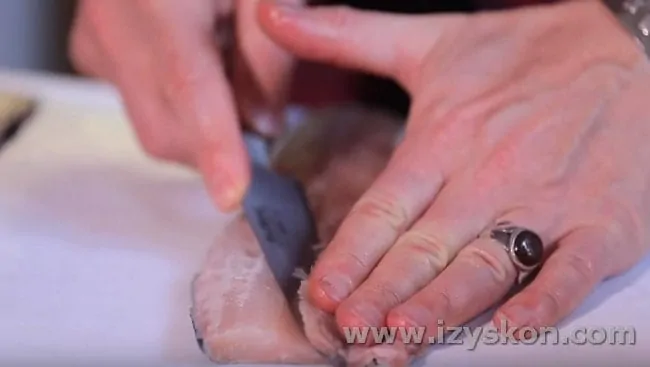
Preparing the fillet for salting
- Cut each part into three to four large pieces.
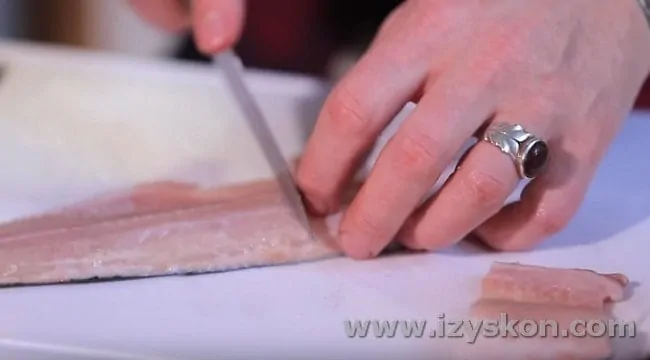
- Pour a liter of cold water into a bowl, add 90 g of coarse salt and stir thoroughly until completely dissolved.
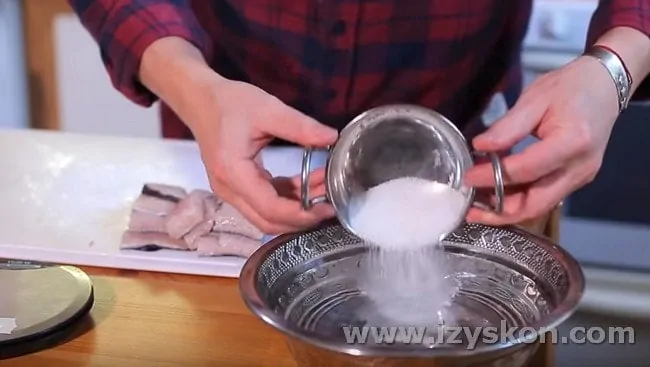
- Place 4-5 pieces in water. bay leaf.
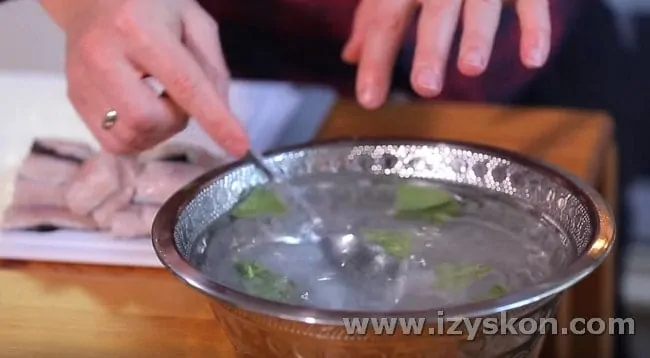
- When the salt is completely dissolved, immerse the pieces of fish fillet in the water. Place the bowl of trout in the refrigerator for two hours.
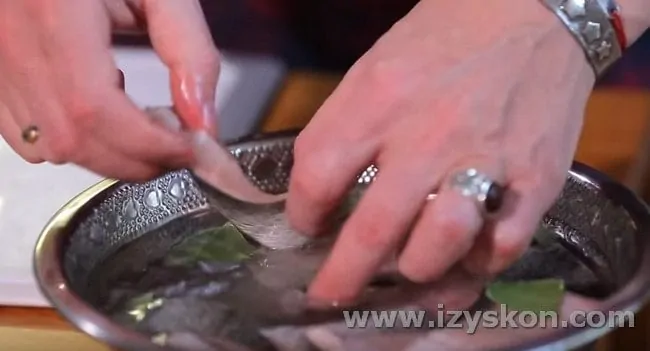
Finish stage
- After exactly two hours, remove the bowl from the refrigerator and remove the fish from the brine. Place fillet pieces on a paper towel to remove excess moisture.
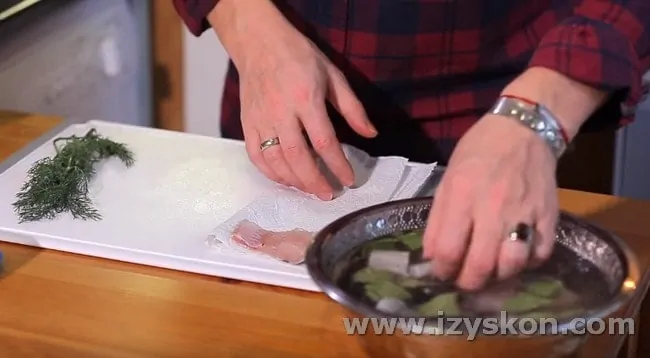
- Roughly chop ½ bunch of dill.

- Place the fish in layers in a container, sprinkling the layers with chopped dill and bay leaves.

- Pour the contents of the container with 1 tbsp. l. vegetable oil, cover with a lid and refrigerate for 3-5 (or more) hours, after which the salted trout will be ready.
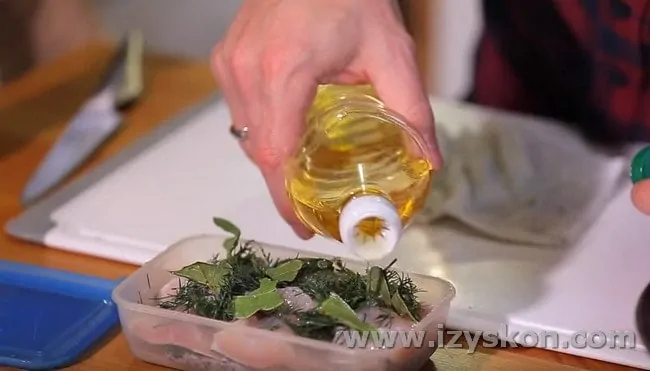
- And then you can try the dish!
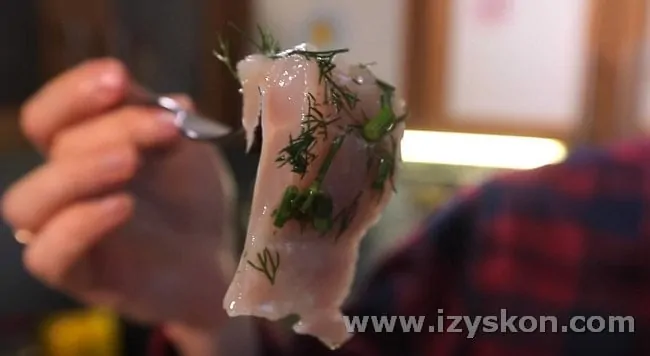
Video recipe
I suggest you carefully watch a master class on preparing fillets and learn how to properly salt fish from chef Vasily Emelianenko. Each of us will greatly benefit from the advice given in the video.
How to quickly pickle fish: homemade brine recipes
Even if you have never prepared anything - salting, pickling, etc. — mastering salting fish will not be difficult: there are no strict proportions or exploding jars, and the results of one or another salting method can be assessed quite quickly and the recipe can be adjusted. It’s especially useful to practice salting at home now - then for the New Year’s table you won’t have to spend money on expensive packaging, but you will be able to buy and salt the fish yourself a few days before the New Year.
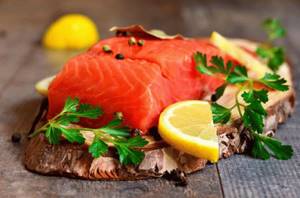
There are three ways to salt fish: dry, in brine and in brine. We are talking specifically about sea (ocean) fish, preferably also frozen. River fish requires deeper processing: it is also salted, but subsequently also dried or smoked.
The types of salting and brine strength are indicated in the table.
| Type of salting | Amount of salt | Readiness | What types of fish is it suitable for? |
| Dry pickling | 15–20% by weight of fish | 3 hours | For whitefish and salmon breeds |
| Brine | 5–10% by weight of fish | from 3 days | For fish that is further planned to be dried or smoked (various roach, roach, bream, sabrefish) |
| Cold brine | 10–15% to water | from 3 days | For fish that you plan to marinate later |
| Hot pickle | 15–20% to water | from 3 hours | For whitefish and salmon breeds |
Quick dry salting
This method, which we often use in everyday life, is suitable for such types of fish as salmon, pink salmon, salmon, sockeye salmon, chum salmon, coho salmon, taimen, chinook salmon, whitefish, omul, vendace. Don't be afraid to add salt - fatty salmon won't take on too much.
For salting, only coarse salt (preferably not iodized) is suitable; you can also add sugar to the salt - it will soften the taste a little and at the same time retain excess water: then the fish will not give too much juice, but will retain it. In addition to sugar, you can add fresh or dried herbs (dill, parsley, tarragon, celery), but not much, as well as multi-colored coarse pepper (or better yet, rose pepper).
The technology is very simple. Cut the fish - remove the head and entrails, you can leave the scales, rub with salt (with or without additives) on all sides, wrap in a clean cloth (or parchment paper). All. You can put it in the refrigerator or leave it at room temperature. You shouldn't leave it in the heat.
Ready time : from three hours. The degree of readiness is determined in the same way as during heat treatment - by the ease of separation of the skin and bones. Indeed, salted fish is much easier to clean from bones than raw fish, so it should not be filleted before salting.
The shelf life of dry-salted fish is quite short - it is advisable to eat it within three days, up to a maximum of five days. But already salted fish can be frozen (in cloth or paper, but not in polyethylene) for future use. You can make salads, cold and hot appetizers with lightly salted fish, and even bake pies with it.
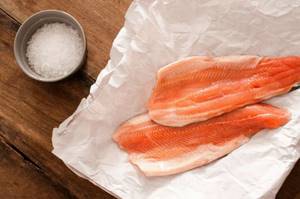
Sprat with spices
Recipes for spicy salted fish are varied. Some people like herring, others like mackerel. But don’t forget about smaller specimens. So, sprat can be an excellent product. It is often sold with the head and entrails. However, in this recipe the fish will need to be processed.
For spicy salted fish you need to take:
- kilogram of sprat;
- three tablespoons of salt, with top;
- half a teaspoon of black peppercorns;
- five buds of cloves;
- a quarter teaspoon of coriander, preferably in grains;
- a little ground ginger - to taste;
- three bay leaves.
It is better to take a wide dish for this version of spicy fish, so that the fish can be placed. It's better to stick to a glass bowl. This recipe can be used to prepare any small fish, such as capelin or herring.
Salting in brine
This is a more reliable option for storing fish. Fish is also salted dry (but without adding sugar), quite generously, not wrapped in cloth or paper, but placed in a pan or jar. After this, oppression is placed on top of the fish. Under the influence of oppression, juice is released from the fish, forming, together with salt, the very brine that should cover the entire fish.
Ready time : from three days. If the brine becomes cloudy, it must be drained. But the shelf life increases: salted fish in brine (to which you can add vegetable oil if desired) is stored for up to 10–15 days. Small fish are suitable for this method: sprat, anchovy, etc., the size of which allows you to salt it whole.
Salted herring in marinade
Ingredients:
1. Frozen mackerel 2 pcs. (large) 2. Salt 1.5 tbsp. 3. Sugar 0.5 tbsp. 4. Bay leaf 4 pcs. 5. Black peppercorns 8-10 pcs. 6. Seasoning such as “Kukharek” or “Vegetta”, containing dried carrots 1 tsp.
Preparation:
1. Rinse slightly thawed mackerel, clean the insides, cut off the head and tail, dry with a towel, cut into pieces about 1 cm thick. 2. Mix sugar, salt, Vegeta, peppercorns and chopped (broken by hand) bay leaf in a bowl . 3. Sprinkle the mackerel with the resulting seasonings, place in a bowl and cover with a lid. 4. Salt for at least 24 hours in the refrigerator.
Ingredients: 1 kg mackerel fillet; 2 tbsp. spoons of salt; 2 tbsp. spoons of sugar; spices to taste
Wash the fish fillet, sprinkle with sugar and salt mixed with spices. Place in layers in an enamel container (for example, in a rectangular enamel bowl), place a load on top. Place the container with fish in the refrigerator.
After 24 hours, remove the weight, remove the fish from the brine and store in the refrigerator.
Thaw freshly frozen fish, cut off the heads, gut, and wash. Place the milk or caviar back into the bellies. Choose a vessel that is wide and low so that the fish fits tightly one to the other, but is located in one layer. For each fish (the weight of one fish is approximately 300 g) take 1 level tablespoon of salt, black pepper and allspice. Cover with a flat plate and place under a weight, leave at room temperature for 4 days (turn the fish over after 2 days from the start of the process). After this period, cut the fish into portions, add onion, cut into large rings, pour in refined oil, and keep in the refrigerator under pressure.
Therefore, after salting, it can be taken out of the brine, cut and filled with oil, since there is no oxygen in the oil, bacteria practically do not live there (if stored in the refrigerator, of course) and the fish will last longer.
Salt “squeezes” liquid out of the cells due to the high asmatic pressure that it creates in the cells during salting, so brine appears and the fish becomes harsh and dry. And sugar makes the salt concentration weaker and also gives additional flavor to the fish, so sugar is added to make the fish more tender.
you will need: mackerel - 2-3 pcs.; dill (chopped) - 2 tbsp.
for the marinade:
salt - 1/2 tbsp. sugar - 1/2 tbsp. white pepper (ground) - 1/4 tsp. mustard - 0.5-1 tsp. vegetable oil - 1/2 cup apple cider vinegar - 2-3 tbsp.
Cut the prepared fish into fillets (with skin). Cut each fillet diagonally into thin, skinless slices.
Place a little chopped dill on the bottom of the bowl, then a layer of fish, dill again, etc.
Mix the ingredients for the marinade, season and add more spices if desired. Pour the prepared marinade over the fish (you can slightly lift the slices with a fork so that the marinade penetrates between them). Leave in a cool place for 2-3 hours.
Pickled mackerel can be used on sandwiches and as a cold snack. To decorate, place dill leaves on top.
Prepared according to this recipe, it turns out very tender, with a slight sourness, which adds piquancy to this fish. It is recommended to salt only mackerel with this marinade. To prepare pickled mackerel with sourness you will need: To pickle mackerel: 2 mackerel; 150 ml water; 30 g salt.
For the marinade: 200 ml apple or wine vinegar; 30 g sugar; 1 tsp. chili pepper; 6 white peppercorns; 6 black peppercorns; 2 peas of allspice; 0.5 tsp mustard seeds; 1 bay leaf.
Clean the mackerel from the entrails and cut off the head. Mix water, salt for pickling and pour over fish. Leave to salt for 8-12 hours depending on the degree of salting desired. Mix white pepper, black pepper, allspice and chili and crush into crumbs. Add all the spices included in the marinade to the vinegar and bring to a boil until the sugar is completely dissolved. Drain the salt water from the fish and pour our marinade over the mackerel. Leave for 2 days; mackerel must be turned over occasionally.
Mackerel is one of the most useful fish. Therefore, it is recommended to use it quite often.
You will need: mackerel - 1 pc.; onions - 2 pcs.; garlic - 2 cloves; coarse salt - 2 tbsp. l. (or to taste); any vinegar - 3 tbsp. l.; vegetable oil - 2 tbsp. l.; black peppercorns -10 pcs.
Wash the mackerel, gut it and cut into pieces. Salt the mackerel. Cut the onion into thin rings. Finely chop the garlic. Place the onion and garlic in a bowl and add black peppercorns to them. Mix vegetable oil and vinegar in a glass. Add mackerel pieces to the onion and garlic, pour the dressing from the glass and mix everything thoroughly. Then, transfer the entire contents of the bowl into a jar, compacting tightly. Close the jar with a lid and put it in the refrigerator to marinate. The next day, the marinated mackerel is ready.
Dishes from seafood, mussels, scallops Squid, recipes from squid and greens Paella, seafood cocktail recipes Hoi tod Thai pancakes with mussels Soups and salads with seafood Recipes from mussels, shrimp Lightly salted herring, how to pickle spicy salted herring Fish, fish dishes.
